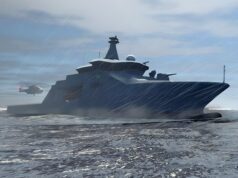The commanding officer of the UK’s new supercarrier, HMS Queen Elizabeth, has expressed a desire for US Marine Corps aircraft to join his own on deck.
As reported by Defense News, the Captain of HMS Queen Elizabeth would like to see US Marine Corps F-35Bs and MV-22s embark ‘for up to nine months at a time’ after the vessel enters service.
Capt. Jerry Kyd said:
“We’ll certainly see some footprint aboard the ship. The big question is do they deploy with us much longer term in the future, maybe for six, seven, eight, nine months from when we deploy. That’s what I would love to see.”
According to Defense News, Kyd also said the V-22’s most important role would be its ability to provide air-to-air refueling.
“That’s really attractive to me. It extends the range and makes my deck cycle time that much easier. V-22 for me would be Christmas, although its expensive.”
Plans for frequent deployment of American F-35 aircraft alongside British jets aboard HMS Queen Elizabeth have been confirmed by Defence Secretary Michael Fallon.
Defence Secretary Michael Fallon confirmed that the US will deploy F-35B aircraft on board the Royal Navy’s new aircraft carrier HMS Queen Elizabeth when it comes into service, with British jets expected to do the same on US vessels when required “in the fullness of time”.
The Ministry of Defence have clarified the details surrounding the Queen Elizabeth class aircraft carriers and their complement of F-35 aircraft, no doubt in response to the plethora of claims that the vessels will sail with “no aircraft”, “no crew”, no sandwiches in the galley etc.
There has been speculation in the media that there has been a change in the delivery programme for the F-35B that may result in delays to the roll out of the Carrier Strike capability and that US jets may fly from the Carriers until the UK F-35 fleet is ready.
This is not the case.
- It was always the intention to take a phased approach to ordering F-35.
- The UK is committed to both the F-35 and the Queen Elizabeth Carrier programmes, both of which are on track to enter initial maritime operating capability in December 2020 as planned.
- Queen Elizabeth will commence sea trials in 2017, and UK F-35 aircraft will be used for first of class flying trials in 2018.
- US aircraft will augment British jets on coalition operations, not replace them and they will not fly from the vessel first.
The US Marines are likely to deploy MV-22 tiltrotor aircraft alongside their F-35s aboard Britains new Queen Elizabeth class carriers.
It is understood that the deployment will not be permanent but will likely be routine.
This comes as plans for frequent deployment of American F-35 aircraft alongside British jets aboard HMS Queen Elizabeth have been confirmed by Defence Secretary Michael Fallon.
Defence Secretary Michael Fallon confirmed that the US will deploy F-35B aircraft on board the Royal Navy’s new aircraft carrier HMS Queen Elizabeth when it comes into service, with British jets expected to do the same on US vessels when required “in the fullness of time”.
The following image shows how an air group on the vessel might be configured.

The image above comes from the following presentation by Captain Nick Walker of the Royal Navy and discusses carrier strike aviation. The slides show how the service plan to operate the vessels and their air group.
The slideshow can be found here.

The Queen Elizabeth class mark a change from expressing carrier power in terms of number of aircraft carried, to the number of sortie’s that can be generated from the deck.
The class are not the largest class of carrier in the world but they are most likely the smallest and least expensive carrier the Royal Navy could build which still have the advantages that large carriers offer.













The other really interesting thing coming out of the reports from Kyd’s interview, e.g. as reported by DefenceNews (http://www.defensenews.com/articles/british-naval-commander-wants-us-marine-aviation-on-aircraft-carrier) is this…
“The base design of the carrier is for a force of 36 jets and four helicopters, but Kyd reckoned the number of jets could eventually be nearly doubled if required.”
That claim has been discussed on a few forums and not considered totally ridiculous. Not that we (the UK) are likely to ever have enough aircraft to fill them but personally it does hearten me to know that we might be getting more theoretical capability for our money than I first thought. A capacity of 40 airframes with possible surge to 50 did always seem a bit low to me for a 70,000 ton carrier.
The QE carrier will be the 11th US large flat-top.
Just as well too…. with so few F-35Bs being purchased they will need US planes to stop the carrier looking so empty
from what i gathered a while back… the qe carriers will be capable of doing 110 sorties per day as opposed to nimitz 120. i dont see what all of the fuss is about.
They seem to be very fine vessels, I hope they are both fully equipped and used..A grand world tour with commonwealth naval forces would raise the flag again, post Brexit..Now all we need is a state of the art air defence destroyer to protect them that doesn’t blow a fuse when someone turns a light on.. Duncan
Does the QE have internal aircraft storage and lifts? The diagram shows ~40 aircraft, and if there is internal storage surely the number can be pushed up a fair amount. For its size, there seems to be a fair amount we have missed out on (catapult systems, large capacity etc)
Yes she does.
I think british should buy V-22 or AW609 for Multi-Roles or sort of “modules” can adaption when required to save cost, and maximum potential for british carrier ability.
they can use roles as
Refuelling
Transport for SF or Royal marine
AEW&C Refit use Merlin AEW&C Equipment upgrade AEW Radar on top for Extra-range